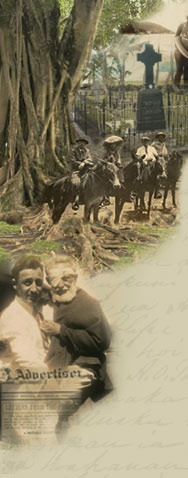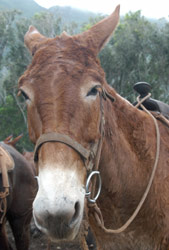|

|
|
|  As
we approached Kalaupapa I could see that the runway began abruptly
in jagged rocks with huge waves crashing over them. It was very
dramatic. Nik landed the plane without a bump and we collected
all our gear and told him we'd see him in two days. He hopped
into his plane and flew off the edge of the runway and back up
into the clouds. As
we approached Kalaupapa I could see that the runway began abruptly
in jagged rocks with huge waves crashing over them. It was very
dramatic. Nik landed the plane without a bump and we collected
all our gear and told him we'd see him in two days. He hopped
into his plane and flew off the edge of the runway and back up
into the clouds.
Pat
Boland was waiting there for us. Pat is a tour guide for the Father
Damien Tours as well as a Kalaupapa historian and historical letter
collector. We had reservations for the tour that morning so we
had to hurry to the Visitor's Quarters and drop our things off
and grab some lunch items. Cathrine, a friend of Val's, had graciously
offered us the use of her van while we were there, and now we
all piled into it as Pat got the old tour bus started and said
he's pick us up soon.
We
quickly put the food away and took the first three rooms in the
Visitor's Quarters. There are around eight rooms, and two bathrooms
with two stalls and one shower each.
|
|  It's
all very bright and cheerful, with two single beds in each room
with folded towels and washcloths on them. I had the room in between
Val and my parents. I threw my camera cover and blue beach bag
(I've never traveled so light!) on the bed just as Pat pulled
up with the bus. We hopped on and went to collect the people who
had hiked or ridden donkeys down the Pali for the tour. It's
all very bright and cheerful, with two single beds in each room
with folded towels and washcloths on them. I had the room in between
Val and my parents. I threw my camera cover and blue beach bag
(I've never traveled so light!) on the bed just as Pat pulled
up with the bus. We hopped on and went to collect the people who
had hiked or ridden donkeys down the Pali for the tour.
Some
of the people were there waiting for the bus, along with some
bored looking donkeys and a group of cats, mostly orange tabbies.
There are a lot of "wild" cats roaming Kalaupapa, and
as you might imagine, they all look as if they have some DNA in
common. Pat got a bucket of cat food from under his seat and sprinkled
it on the ground for them. They didn't look very wild then.
We sat for a while waiting for a few hikers who were still on
their way down the muddy, steep Pali trail. It had rained really
hard the night before, and the stormy morning hadn't helped conditions.
As we met people later throughout our stay, they would say to
Val: "I didn't think you'd come over in that terrible weather."
She'd just tell them we came over with Nik and they'd say something
like "Oh, Nik, of course." My initial suicidal maniac
theory was starting to hold water.
|
|  As
we waited, Pat started to tell us a bit about Kalaupapa: about
how the supply boat used to come 3 times a year, but now it only
comes once a year, so when it arrives everyone gathers at the
pier and comments on their neighbor's new couch, car, etc. As
we waited, Pat started to tell us a bit about Kalaupapa: about
how the supply boat used to come 3 times a year, but now it only
comes once a year, so when it arrives everyone gathers at the
pier and comments on their neighbor's new couch, car, etc.
Most of the people have 2 or 3 cars, because if one breaks down,
it may be 7 months or more before they can get it repaired or
get parts. The small Kalaupapa store gets it's groceries from
a supply plane that comes once a week.
By
now we could see a couple of hikers coming over the hill. One
man was around 60 and was streaked in mud - he apparently had
fallen a couple of times, but was being very nonchalant about
it. The last of the donkeys were corralled and all our hikers
were with us, so we started off on the Father Damien Tour. Pat
mentioned at one point that he felt a little nervous: Val is quite
an authority on Kalaupapa, and he would ask her from time to time
if she had anything to add.
|
 He also told our fellow tourists that "We have a special
guest with us today" and introduced my mother Leslie. My
parents were sitting right behind Pat and later in the tour he
heard her reminiscing and handed his microphone over his shoulder
to her so she could share her memories with everyone. I was afraid
she might start singing, but she showed good sense and stuck with
narration.
He also told our fellow tourists that "We have a special
guest with us today" and introduced my mother Leslie. My
parents were sitting right behind Pat and later in the tour he
heard her reminiscing and handed his microphone over his shoulder
to her so she could share her memories with everyone. I was afraid
she might start singing, but she showed good sense and stuck with
narration.
Pat
took us to many places, including Kalawao, where the first people
were literally "dropped off" the boats starting on January
6, 1866. We stopped for lunch there, overlooking the rocky shore
and cliffs and it was hard to reconcile the magnificent beauty
of the scenery with the pain those poor souls must have felt,
torn away from their families and deserted at the end of the earth.
It was incredibly isolated then and there was no shelter, supplies,
or tools.
The
primitive shelters they made of branches and dead roots didn't
protect them from the elements, and for most of the year they
couldn't see a sunrise or sunset because of the high cliffs .
The constant dampness and relentlessly howling winds made it impossible
to get warm. Many died of lung disease, with no one to comfort
them in their last hours. Of the 14 new people who arrived each
week, 5 would die.
|
|  It
wasn't until 1873 that the government annexed a portion of Kalaupapa
to ease the overcrowded conditions at Kalawao. Some elected to
remain in Kalawao, despite incentives from the Board of Health.
On May 10, 1873, a 33 year old Catholic priest name Father Damien
arrived at Kalaupapa. It
wasn't until 1873 that the government annexed a portion of Kalaupapa
to ease the overcrowded conditions at Kalawao. Some elected to
remain in Kalawao, despite incentives from the Board of Health.
On May 10, 1873, a 33 year old Catholic priest name Father Damien
arrived at Kalaupapa.
He was supposed to stay three months, but ended up staying until
his death from Leprosy on April 15, 1889. In his 16 years he comforted,
built, planted, taught, defended, and drastically changed the
lives of the people of Kalaupapa.
After
lunch Pat took us to St. Philomena church, where Father Damien
had been laid to rest until 1936. In 1935 King Leopold of Belgium
wrote to President Roosevelt asking that Damien's remains be sent
home to Belgium. The people of Kalaupapa were naturally devastated,
and did everything they could to convince the authorities that
their beloved Father Damien belonged with them. But on January
26, 1936, Damien's remains boarded the ship "Mercator"
for Belgium. Doc was one of those in charge of seeing that everything
went smoothly. You can see
the letter from the Belgian Consulate to Doc, thanking him
for overseeing Damien's return.
An
old Hawaiian tale says that evil will befall anyone who would
remove the bones of a chief from the shores of his land. Indeed,
when the ship departed Honolulu, Captain Edgar S. McLellan, skipper
of the Mercator, was on board, and was even seen at the helm as
it approached the coast of California. When the ship docked at
San Francisco, however, he was nowhere to be found and to this
day his fate is a mystery. (On a previous visit (1935) to Molokai,
a different captain wrote a note to Doc on a postcard,
which is a photo of the Mercator.)
|
 The
tour ended with Pat taking us back to the donkeys and the base
of the trail back up the Pali. It had been a beautiful, informative,
and thought-provoking experience for all of us, I think. Pat was
very knowledgeable, answering all our questions, and he obviously
has great empathy for the plight of those who had suffered so
greatly there. The
tour ended with Pat taking us back to the donkeys and the base
of the trail back up the Pali. It had been a beautiful, informative,
and thought-provoking experience for all of us, I think. Pat was
very knowledgeable, answering all our questions, and he obviously
has great empathy for the plight of those who had suffered so
greatly there.
Since my return home, Pat has been very helpful to me, visiting
the website and identifying people and places I wasn't sure about
or couldn't find out about. After
the tour we took my parents back to the Visitor's Quarters and
Val and I went to the Social Hall to prepare for the party. Val
had gone all out: there were hot dogs, pasta salad, tuna salad,
sodas, and a lovely cake.
Once
we had the tables and chairs set up, we took a quick trip over
to the footprints to make sure we would be able to find them for
the "Footprint Ceremony". It had been a while since
Val had seen them and I was hoping they were still there!
<Previous
Page Next
Page >
|
|
|